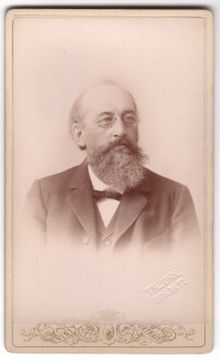bio.wikisort.org - Researcher
Edmund August Friedrich Russow (Russian: Эдму́нд Фридрихович Ру́ссов, romanized: Èdmúnd Fridrichovič Rússov; 24 February [O.S. 12] 1841 – 11 April [O.S. 30 March] 1897) was a Baltic German biologist.
This article includes a list of general references, but it lacks sufficient corresponding inline citations. (August 2021) |
Edmund Russow | |
|---|---|
 | |
| Born | 24 February [O.S. 12] 1841 Reval, Governorate of Estonia, Russian Empire (present-day Tallinn, Estonia) |
| Died | 11 April [O.S. 30 March] 1897 (aged 56) Yuryev, Yuryevsky Uyzed, Governorate of Livonia, Russian Empire (present-day Tartu, Tartu County, Estonia) |
| Nationality | Baltic German |
| Alma mater | Imperial University of Dorpat Friedrich-Wilhelm University of Berlin |
| Scientific career | |
| Institutions | Imperial University of Dorpat |
Academic career
Son of a military engineer, Edmund Russow studied at the Universities of Dorpat (now Tartu, Tartu County, Estonia) and Berlin. In 1867 he became an associate professor at Dorpat, where from 1874 to 1897, he served as a full professor. In 1895-97 he was president of the Estonian Naturalists' Society. Russow was at the forefront of nature conservation in Estonia, and associated with the work of Hugo Conwentz (1865-1922), a founder of nature conservation efforts throughout Europe.
Botanical work
Russow was an authority on Sphagnaceae (sphagnum mosses)[1] and remembered for his research in plant anatomy and histology, in particular studies of the plant family Marsileaceae (aquatic and semi-aquatic ferns).[2] The plant genus Russowia is named in his honor,[3] as is Sphagnum russowii (Russow's sphagnum).
Written works
- Histologie und Entwicklungsgeschichte der Sporenfrucht von Marsilia. Dissertation. Dorpat (1871)
- Entwickelungsgeschichte der Sporenfrucht von Marsilia (1873). In: Mémoires de l'Académie Impériale des Sciences de Saint-Pétersbourg, série VII, tome XIX, p. 42
- Vergleichende Untersuchungen betreffend die Histiologie … der leitbundel Kryptogamen. In: Mémoires de l'Académie Impériale des Sciences de St.-Pétersbourg, 1872
- Betrachtungen über das leitbundel- und grundgewebe aus vergleichend morphologischem und phylogenetischem geschichtspunkt (1875).[4]
References
- Botanical Gazette, Volume 24 By John Merle Coulter, et al
- Google Books, Marsileaceae
- CRC World Dictionary of Plant Names: Common Names, Scientific Names, Eponyms, by Umberto Quattrocchi
- Open Library, authors
- IPNI. Russow.
- "Biographical information based on an equivalent article at the Estonian Wikipedia".
External links
- Works by or about Edmund Russow at Internet Archive
На других языках
- [en] Edmund Russow
[ru] Руссов, Эдмунд Фридрихович
Эдму́нд Фридрихович Ру́ссов (нем. Edmund August Friedrich Russow; 24 февраля [8 марта] 1841—11 [23] апреля 1897) — ботаник, профессор Юрьевского университета.Другой контент может иметь иную лицензию. Перед использованием материалов сайта WikiSort.org внимательно изучите правила лицензирования конкретных элементов наполнения сайта.
WikiSort.org - проект по пересортировке и дополнению контента Википедии